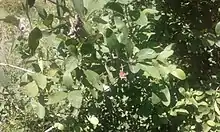Mespilus canescens
Mespilus canescens, commonly known as Stern's medlar, is a large shrub or small tree, recently discovered in Prairie County, Arkansas, United States, and formally named in 1990. It is a critically endangered endemic species, with only 25 plants known, all in one small (9 ha) wood, now protected as the Konecny Grove Natural Area.
| Mespilus canescens | |
|---|---|
 | |
| Scientific classification | |
| Kingdom: | Plantae |
| Clade: | Tracheophytes |
| Clade: | Angiosperms |
| Clade: | Eudicots |
| Clade: | Rosids |
| Order: | Rosales |
| Family: | Rosaceae |
| Genus: | Mespilus |
| Species: | M. canescens |
| Binomial name | |
| Mespilus canescens J.B.Phipps | |
It has been shown by genetic analysis to be closely related to the common medlar Mespilus germanica, which was previously the only known species in the genus. Subsequent molecular analyses suggest that Stern's medlar is likely a hybrid between cultivated M. germanica and one or two native North American species of Crataegus.[1]
Description
Thorns are sparse, 2–3 cm (0.8–1.2 in) long.[2] The leaves are 2–4 cm (0.8–1.6 in) long.[2] The five-petalled white flowers are produced in late spring. The fruit is an almost spherical pome, 8–12 mm (0.3–0.5 in) diameter; it differs from common medlar fruit in being deep glossy red when ripe (not brown).[2]
See also
References
- Lo, E.Y.Y., Stefanovic, S., Dickinson, T.A., 2007. Molecular reappraisal of relationships between Crataegus and Mespilus (Rosaceae, Pyreae) – two genera or one? Systematic Botany 32: 596–616.
- Phipps, J.B. 1990. Mespilus canescens, a new rosaceous endemic from Arkansas. Systematic Botany 15: 26-32.
External links
- Center for Plant Conservation: Mespilus canescens
- Phipps, J.B., Weeden, N.F., & Dickson, E.E. 1991. Isozyme evidence for the naturalness of Mespilus L. (Rosaceae, subfam. Maldoideae). Systematic Botany 16: 546-552.
